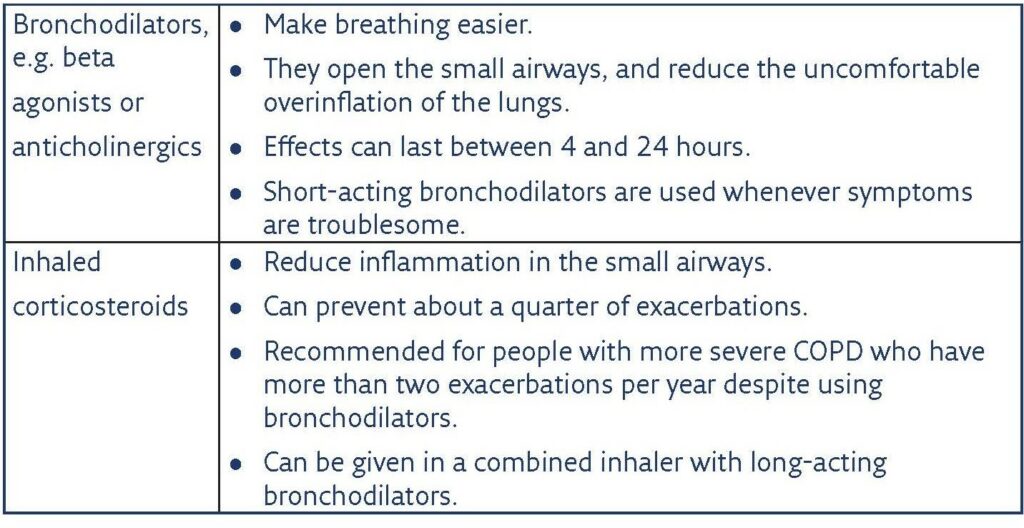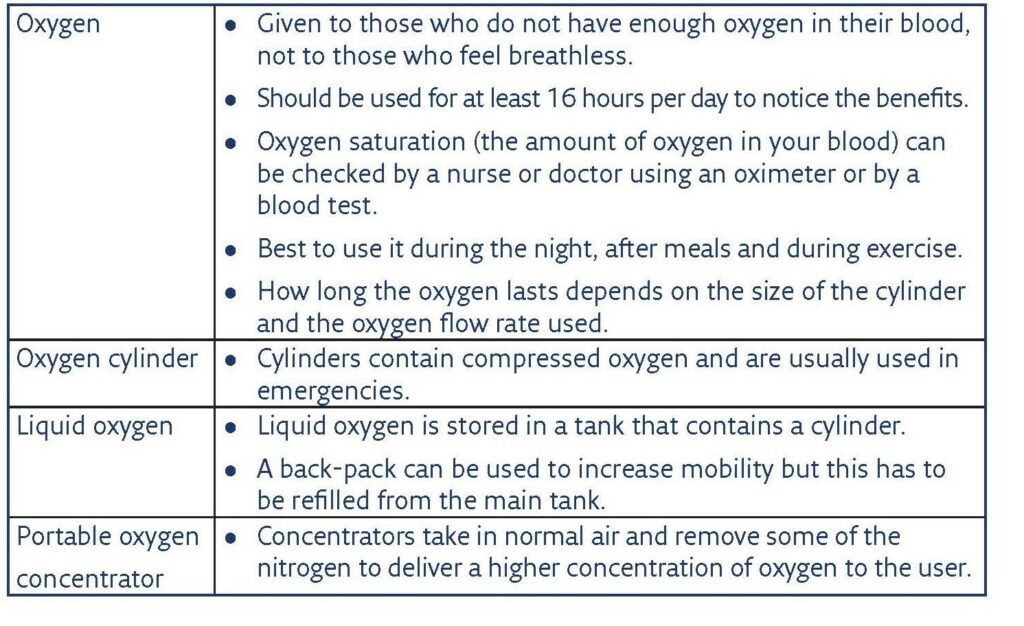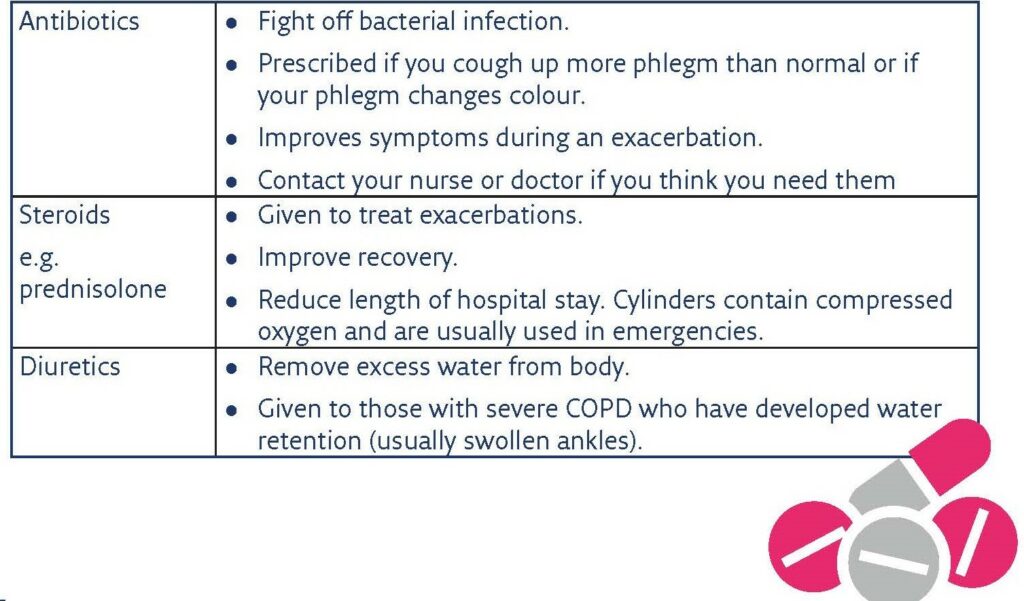Living well with COPD
This page aims to show people with chronic obstructive pulmonary disease (COPD), their friends and family how they can still live a full life with this condition.
Back to: COPD
What is COPD?
COPD is a group of conditions that includes chronic bronchitis and emphysema. Chronic bronchitis (inflamed and narrow airways) prevents the lungs from emptying normally when you breathe out. You will have to make an extra effort to breathe, which can make you feel breathless. Emphysema (damaged lung structure) occurs in the areas of gas exchange, known as the alveoli. Walls of the alveoli become less stretchy and so it is more difficult to empty air out of the lungs. Symptoms, such as shortness of breath, coughing and fatigue (feeling really tired out), gradually worsen and can severely affect quality of life. However, there are many things you can do to help yourself feel better.
What causes COPD?
Many things can cause COPD. In Europe, the most common cause of COPD is cigarette smoking. Breathing in cigarette smoke irritates the airways so they become inflamed and make you cough. If you smoke and have COPD, the first step you should make to help prevent your condition from getting worse is to stop smoking. However, not all smokers develop COPD and some people with COPD have never smoked. Other causes of COPD include: exposure to air pollution, both indoors and outdoors; inhaling certain gases at work over many years; or it can be hereditary. Research has also shown that having asthma as a child could increase a person’s risk of developing COPD.
How can I help my condition?
1. Stop smoking
It is never too late to give up! The benefi ts begin within a few days. Once you quit smoking, the rate at which your lungs age will be the same as a non-smoker.
2. Exercise and breathing
When you exercise or carry out daily activities you may feel breathless. This is not dangerous and the breathlessness disappears rapidly when you stop exercising. Breathlessness can be very uncomfortable and scary but the worst thing you can do is avoid exercise. If you do, you will become unfit and eventually feel even more breathless during simple tasks. Try to exercise as often as you can to improve your overall fitness and well-being; practise by walking up the stairs. Stop when you need to rest and you will feel the shortness of breath disappearing rapidly. Sometimes, breathing through ‘pursed lips’ may help you to catch your breath. Another easy way to exercise is to walk for 20 minutes each day. It is advised that you take your reliever medication before you exercise. This medication will also help to relieve your symptoms when you exercise.
If your breathlessness suddenly becomes worse or does not disappear rapidly after exercise, you should see a doctor. If your breathlessness is becoming troublesome, it is very important that you follow a rehabilitation programme as advised by your doctor. It will help you exercise for longer before feeling breathless, improve your symptoms and enhance your quality of life.
3. Diet
It is important that healthy eating becomes part of your daily routine. You should try to eat lots of fruit and vegetables.
- When you are feeling well, doctors recommend that you eat 3–4 meals a day
- If you are feeling unwell, you should eat 5-6 smaller meals a day of soft foods. Food and drink rich in carbohydrates and proteins such as pasta, chicken and fish are preferable.
Being overweight will make your breathing even more difficult. However, if you are underweight for your height you may need a special diet. It is okay to drink alcohol with meals, as long as it is in moderation.
What should I do if my condition worsens?
A noticeable worsening of your condition is called an exacerbation. When this occurs, you will experience more symptoms than normal, which might be more severe than you are used to. This can be very distressing. Exacerbations are often triggered by a normal cold or during times of bad weather. They can last for different amounts of time but usually between 7 to 21 days. If they last longer, you may need extra treatment from your doctor.
What treatment will I be prescribed by my doctor?
Inhalers
There are several types of inhaler that can be used to deliver these drugs and they all work slightly differently. Make sure you know exactly how to use your inhaler as there may be a special way of putting it together or cleaning it to make sure it works effectively.

Oxygen

Tablets

General practical advice
Clothing
Wear suitable clothes for the time of year. Try to wear loose garments that are easy to put on.
Heating
Keep your home at a temperature between 19 and 21˚C. Cold temperatures may make you feel worse.
Holidays
If you have COPD you can still go on holiday. If you are flying, you must check with the airline before you fly and give them as much notice as possible. Visit the air travel section for further details.
Housework
Avoid using strong chemical products such as polish and paints, as they may irritate your airways and worsen your symptoms.
Leisure
Visit your friends as often as you can. When you prefer to stay at home, keep yourself entertained by listening to music or simply just relax.
Sex
COPD symptoms and treatment may reduce your urge to have sex but this does not mean it is dangerous for you to do so. Slight increases in heart and breathing rate are normal.
Sleep
Establish a routine for going to bed, getting up and resting. Avoid sleeping too much during the day – or drinking too much alcohol or caffeine – or you will find it difficult to sleep at night.
Vaccinations
Infections, such as flu, COVID-19 or pneumonia, can easily infect your lungs as they are more susceptible compared with healthy people. Doctors recommend that you have a flu vaccine each year and a pneumonia vaccine if you are over 65 years old. You should also have your COVID-19 vaccine.
How will my illness be monitored?
It is important that you regularly visit your doctor or nurse. They will ask how you are feeling and whether your treatment is working. This is your opportunity to talk to your healthcare professional about how you are feeling, your symptoms and your needs. They may listen to your breathing with a stethoscope and assess whether your treatment needs changing. Tests that your doctor might perform to check your condition include:
• A spirometry test. This test is used to diagnose COPD and may help to show how your illness is progressing. The test involves taking in as deep a breath as possible to fill your lungs with air and breathing out as hard and fast as you can for at least 6 seconds into a machine.
• Oximetry. This is a very simple and painless way to check whether you have enough oxygen in your blood. It detects the colour of the blood pulsating through the tip of your finger. If the reading is low you may be advised to have arterial blood gasometry. This measures exactly how much oxygen and carbon dioxide you have in your blood and will tell the doctor whether you need extra oxygen.
• A quality of life questionnaire. This will include questions that ask how you are feeling and how you cope with certain activities. It will show whether your treatment is helping your condition.
• An X-ray of your chest. This test will help to rule out any other possible causes of your symptoms, and will highlight any obvious obstructions.
• A six-minute walk test. This shows the doctor how far you can walk in six minutes and how difficult you find it.
What will make me feel worse?
- Continuing to smoke.
- Not taking the recommended treatment.
- Using your inhaler incorrectly.
- Not dealing with other illnesses.
- Not keeping regular appointments with your doctor.
- Limited interaction with your friends and family.
- Not completing 20 minutes of daily exercise.
How will I know if my condition is worsening?
You feel more short of breath than usual. If this happens:
- Check your self-management programme and follow the advice.
- Keep calm.
- Take your rescue inhalers.
- Start emergency treatment if you have it.
- If you use oxygen, have it on all day but do not increase the amount that your doctor has prescribed.
- Try doing the relaxation and breathing techniques demonstrated to you by your doctor.
- Move around more slowly.
You may notice that you are producing more phlegm than normal. It may change colour and become thicker, which is harder to cough up.
Your legs and feet may become swollen. If this happens:
- Keep your feet raised.
- See a healthcare professional if the problem does not go away within 3 days.
If you experience any of the following, please see your doctor:
- Coughing up blood
- Being more short of breath than normal
- More phlegm and a change in its colour
- Swollen legs and feet
- Pain in the side of your chest when you take a breath
- Drowsiness
- Mood swings.
Exacerbations
If you regularly experience exacerbations, it may have a disabling effect on your overall well-being that can last for months. Your illness will progress and you may have a lower quality of life. You should speak to your doctor about how to avoid worsening symptoms and how to manage them if they do get worse. Your doctor can work with you on a written action plan with goals that work for you. Steroids and antibiotics may be given to control symptoms and fight off infection, as infections often cause exacerbations. If you have an annual flu vaccine along with your normal medication, you will greatly reduce the risk of catching flu. If you experience a very serious exacerbation, you may go into hospital so that doctors can control your symptoms and give you more suitable treatment.




